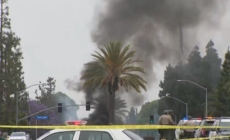-
Will the Santa Cruz Wharf be rebuilt after it broke apart? - 21 mins ago
-
Braves vs. Giants Highlights | MLB on FOX - 24 mins ago
-
Teacher’s Award for Girl in Seventh Grade Sparks Debate: ‘Poor Kiddo’ - 47 mins ago
-
Democrats are busy bashing themselves. Needed, or just needy? - 60 mins ago
-
Rangers vs. Nationals Highlights | MLB on FOX - about 1 hour ago
-
Unique Father’s Day gifts for tech dads, from laptops to pool cleaners - about 1 hour ago
-
When ‘Real Housewives’ Makes Women Want to Be More Than Housewives - about 1 hour ago
-
The National Guard comes to Los Angeles: What’s going to happen? Is it legal? - 2 hours ago
-
Hong Kong opera puts Trump on stage with Mao, Kim and more - 2 hours ago
-
Royals vs. White Sox Highlights | MLB on FOX - 2 hours ago
California Drought: Map Shows ‘Abnormally Dry’ Conditions Set to Fuel Fires
Despite fierce rainstorms and atmospheric rivers battering California in recent weeks, the state continues to grapple with significant drought conditions, fuelling “extreme” fire weather this week.
In its latest drought map, the U.S. Drought Monitor revealed that 59.1 percent of California is under “abnormally dry” conditions.
From the northern reaches of Lassen County to the Bay Area and the Central Valley, and worsening further south, areas like San Bernardino, Riverside and Imperial counties face “moderate” to “extreme” drought levels.
Nearly 19 million Californians live in drought-affected areas, even as California’s reservoirs maintain above-average levels.
U.S. Drought Monitor
Why Is There a Drought in California Despite Recent Rains?
While parts of Northern California received substantial rain in late December—some regions recorded up to 8 inches above normal precipitation—this rainfall has not translated into widespread drought relief.
Southern California, in particular, remains dry, with moderate drought expanding across neighboring states such as Nevada and Arizona.
It may be due to climate change. Research published in October by experts at the University of California Merced showed that California takes about three months longer to recover from drought due to a warming planet.
“Climate change has fundamentally changed the odds of getting out of drought. It has weighted the dice,” Emily Williams, a postdoctoral scholar with the Sierra Nevada Research Institute, said in a statement. “This is happening because of warming in the summer months, and a good portion of it is because of human-caused climate change.”
What Areas of the State Are Most Affected?
The drought map highlights significant disparities across the state. While Northern California and parts of the Bay Area received recent rainfall, drought conditions have worsened in Southern California.
Counties such as San Bernardino, Riverside and Imperial are experiencing moderate to extreme drought. Portions of the Bay Area, including Alameda, Contra Costa and Santa Clara counties, are also heavily affected.

Jae C. Hong/AP Photo
“Extreme” Fire Risks This Week
It may be the middle of winter, but the dry conditions are expected to fuel “extreme fire conditions” this week, according to the National Weather Service (NWS).
The NWS office in Los Angeles has issued a warning for most of Los Angeles and Ventura counties from Tuesday afternoon through Wednesday.
“Widespread damaging winds and low humidity will likely cause fire starts to rapidly grow in size with extreme fire behavior,” the NWS said.
Newsweek reached out to the NWS via email for comment.
What Impact Is This Having on Crops and Pastures?
Dry conditions are threatening California’s agricultural sector. Abnormally dry conditions can stunt crop germination, according to the U.S. Drought Monitor.
As the drought levels increase, crop growth becomes stunted, grazing land can become inadequate, and at the extreme level, irrigation contracts may not be able to be met.
Farmers may face mounting challenges, including higher costs for water and potential crop losses, exacerbating concerns for one of the nation’s most important agricultural regions.
What Impact Is This Having on Water Resources?
Despite the drought, California’s reservoirs remain at reasonable levels for this time of year.
Lake Shasta, the state’s largest reservoir, is at 130 percent of its historical average, while others, like Lake Oroville, hover around 128 percent. All other major reservoirs in the state are close to or above their historical averages, too, according to data from the California Department of Water Resources.
Do you have a tip on a science story that Newsweek should be covering? Do you have a question about California’s drought? Let us know via science@newsweek.com.
Source link































